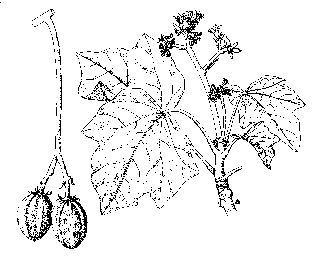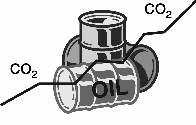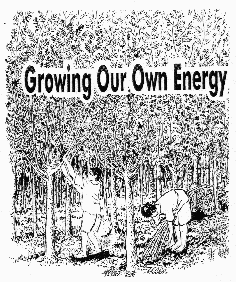 COUNTRY COMPASS
COUNTRY COMPASS COUNTRY COMPASS
COUNTRY COMPASSBhutanese rural households without access to electricity rely on five types of energy carriers: fuelwood, kerosene, dry cell batteries, animal power and human power.
Fuelwood is the most common energy carrier and is used for cooking, space heating, animal fodder preparation and water heating; however, its collection requires significant labour. A rural household in Bhutan typically spends the equivalent of 25 person-days per year cutting, splitting, drying and transporting fuelwood.
This human power requirement competes or conflicts with the need for human labour in agricultural or other types of production, thus leading to a major constraint on development in rural Bhutan. All fuelwood that can be substituted is therefore likely to lead to improved livelihoods by freeing labour for more productive activities.
Bhutan has one of the highest per caput levels of fuelwood consumption in the world, estimated at over one tonne per person per year. (Source: Renewable Energy for Development, 13[1], March 2000.)
Los aceites comestibles y grasas animales podrían
transformarse a nivel competitivo en ecodiesel?
En un país de la UE
circulan autobuses, denominados «ómnibuses verdes», que ha sido adaptados al uso
de combustibles naturales (ecodiesel), derivados de la destilación de aceites
provenientes de frituras. Este tipo de vehículo abastecido con ecodiesel es el
orgullo de los investigadores y de los habitantes de ese país. Esta energía
renovable a bajo costo, proveniente de aceites de frituras, está siendo
recolectada por una cadena regional de restaurantes, hoteles, residencias,
industrias alimentarias e industrias del sector alimentario alternativo. Todos
los días, millones de litros de aceites usados vienen transformados en
ecodiesel. Los autobuses que circulan transportando pasajeros que apoyan la  iniciativa, promueven además el desarrollo de una actitud ecológicamente
responsable mediante atractivos afiches relacionados el tema.
iniciativa, promueven además el desarrollo de una actitud ecológicamente
responsable mediante atractivos afiches relacionados el tema.
Este
proyecto será tomado en consideración por el Brasil donde, al parecer, los
institutos de investigación, las petroquímicas, las universidades, las
industrias, las compañías de transporte, las asociaciones y las cooperativas de
usuarios de líneas urbanas, los fabricantes de motores, entre otros, estarían
interesados en un plan similar a corto plazo. En el Brasil, donde existen
grandes volúmenes disponibles de grasas animales que se descargan al medio
ambiente sin un adecuado tratamiento, constituyendo un serio problema social que
afecta al medio ambiente natural, un proyecto de este tipo podría constituir
también una oportunidad empresarial interesante.
Las industrias
fabricantes de autobuses urbanos de Brasil, se han mostrado interesadas en el
tema conjuntamente a las industrias de motores diesel, cuyos motores podrían
adaptarse al ecodiesel para un uso ecológico apropiado en los medios de transporte.
(Fuente: Gert Roland Fischer)
Para más información, dirigirse a:
Gert Roland Fischer,
correo electrónico: [email protected] ,
www.ekolink.com.br,
y consultar el artículo titulado «Suecia»
Since wood is the only fuel used in tobacco curing barns, environmental preservation and reforestation practices are common incentives adopted by the tobacco sector. Wood accounts for 11 percent of the production costs, which is a powerful incentive for growers to plant trees. In 1992, the tobacco industry reached an agreement with the Brazilian Environmental Institute (IBAMA), which made it mandatory for tobacco growers to plant 500 wood-producing trees per year per tobacco curing barn, for five consecutive years.

As a result, tobacco farmers now have larger forest reserves than any other farming group. In the main tobacco-growing state of Rio Grande do Sul, tobacco growers' holdings have forest cover on 26.8 percent of land, compared with the 5 percent cover for the whole state. In the other two tobacco-growing states of Santa Catarina and Parana, the proportion is 35 percent to 17 percent. Plantations are renewed either by regeneration of the cut trees or by replanting. (Source: The use of woodfuel for curing tobacco, a publication of the International Tobacco Growers' Association [ITGA]; www.tobaccoleaf.org/publications/infot11.htm )
The Energy Research Institute of the Henan Academy of Sciences, in cooperation with Iowa State University, United States, the Nanyang Guanghui Machinery Factory and Zhengzhou University, has carried out a project to design, build and test a biomass conversion system including a fluidized bed gasifier, feedstock feeding equipment and a gas cleaning train. The gasification system is designed for centralized cooking gas stations for 100 to 400 families and fuelled with peanut shells, rice husk, sawdust, corn stalks, wheat straw and other agricultural and forestry residues.

The first phase of the project has been successfully completed and highly appraised by the Henan Science and Technology Department. The gasification system has been used for villagers' cooking gas supply in China and the households are very satisfied with the cooking gas.
The technology would also be useful for other developing countries and the Energy Research Institute hopes to disseminate it to as many other countries as possible.
For more information, please contact:
Prof. Yang Hongxiu, Energy Research Institute, Henan Academy of Sciences, 29 Huayuan Road, Zhengzhou, Henan, China.
Fax: +86 371 5717871;
e-mail: [email protected]
A new renewable fuels programme in Colombia aims to improve environmental standards while making better use of domestic resources, providing an economic stimulus to the rural economy and reducing CO2 emissions. The programme will include the expanded cultivation of sugar cane and the construction of 12 new biorefineries for ethanol production and blending with gasoline.
The Corporation for Development of Biotechnology and Clean Technologies (CORPODIB), a governmental/private entity, has developed an ambitious programme for renewable transport fuels. The programme aims to reduce mobile source emissions and conform to Colombian environmental regulations requiring use of oxygenates in gasoline as of 2001. The High Chamber of Congress recently approved an innovative law requiring the use of bioalcohol in all Colombian gasoline after 2003. The environmental benefits of the programme range from local impacts in the form of improved air quality to a global contribution through CO2 reduction.

Colombia's Ecopetrol refineries do not produce enough gasoline to satisfy the domestic demand, and the balance is imported as high-octane gasoline. Ethanol from sugar cane offers an octane enhancer that can meet the quality requirements while also saving costly investments at the Ecopetrol refineries. An immediate goal of the CORPODIB project, therefore, is to produce sufficient anhydrous ethanol from sugar cane for a 10 percent blend with gasoline; this would require 730 million litres of ethanol per year, which is roughly equivalent to current gasoline imports in Colombia.
At present, 500 000 ha of sugar cane are cultivated in Colombia. It is estimated that the new ethanol programme will require the planting of an additional 150 000 ha, distributed in different regions of the country. It will also require the construction of 12 biorefineries during the first phase of the project. The agro-industrial complexes will be located close to the more suitable regions for sugar cane and around demand centres for gasoline.
It is expected that the programme will generate 150 000 new jobs, mainly in the agricultural sector.
A 10 percent ethanol fuel does not require any modification in vehicle engines, and the Brazilian experience with ethanol shows that it is possible to go up to a 25 percent blend.
Production of biofuels, such as ethanol from sugar cane, take advantage of year-round cultivation potential in a tropical country such as Colombia and benefits extend from local to regional to national to global.
This project could be replicated elsewhere and CORPODIB looks forward to a regional and global dialogue on the increasing use of ethanol and other renewable fuels to promote sustainable development. (Source: Renewable Energy for Development, 13[3], October 2000.)
For more information, please contact:
Mr Henry Echeverri-Campuzano, Energy and Environmental Advisor, CORPODIB, Bogotá, Colombia.
E-mail: [email protected]
Under the Kyoto Protocol, Finland has to stabilize its greenhouse gas emissions to the level of 1990. The task is demanding, since energy use is increasing and the target level has now been exceeded.
In order to reduce CO2 emissions, renewable energy must be substituted for fossil fuels. Since Finland is a country with large forest resources and a well-developed forest sector, wood is the primary source of renewable energy. In fact, wood-based fuels already produce 19 percent of the total consumption of primary energy.
The main source of wood energy is processing residues from the forest industries, i.e. bark, sawdust and black liquor. However, practically all industrial wood residues are already used for the production of energy or the raw material of pulp. Therefore, the increase in the use of woodfuels must be based on the unutilized biomass reserves of the forests, either small-sized trees from young plantations or logging residues from the final harvest.
The adoption of fully mechanized logging technology, i.e. the cutting of timber with single-grip harvesters and off-road transportation to road side with load-carrying forwarders, has made residues from final harvest an attractive and cost-competitive source of energy. The same equipment can be used for harvesting industrial raw material and fuel, and the procurement logistics can be improved through integration of operations. About 500 000 m3 solid of residues will be salvaged from regeneration areas and reduced to fuel chips in 2000, and the amount is increasing rapidly. Production of energy is becoming a new dimension of the forest management system.

When the recovery is extended to fuel, trees and tree parts that have traditionally been left unutilized because of their small size or unsuitable technical properties become marketable. In Finnish conditions where forests are thinned repeatedly, the content of stemwood is only 10 percent and that of crown mass 90 percent in the logging residues from final harvest. Crown mass composed of branches and foliage is thus an essential part of the energy potential of conventional forestry.
In the traditional stem-only harvesting, the nutrient loss from timber removal and leaching is compensated by atmospheric precipitation, chemical weathering and the biological fixation of nitrogen; therefore the nutrient balance of the site and sustainability of the ecosystem are not endangered. When the harvest is expanded to nutrient-rich crown mass, the situation changes. The loss of nutrients, particularly nitrogen and phosphorus, increases radically. Each percentage increase in biomass recovery through the salvage of crown mass with foliage is accompanied by a nutrient loss increase of some 2-3 percent for Scots pine, 3-4 percent for Norway spruce and 1-2 percent for leafless northern hardwoods.
However, the sustainability of wood production must not be endangered through an improper management practice. It follows that guidelines and harvesting technology must be developed to avoid potential risks. The following means are commonly recommended:
· Crown mass should not be removed from sensitive sites where nutrient deficiencies occur or may occur.
· Crown mass should not be recovered repeatedly in successive logging operations at the same site, and not more than 60 to 80 percent of the crown mass should be recovered in the final harvest.
· As the removal of nutrients is dependent on the extent of needle recovery, transpiration drying can be used to shed a part of the foliage before the residues are removed. It follows that the recovery of fuel is reduced, the cost of harvesting is increased, and the flow of fuel from logging site to plant slows down, but simultaneously the loss of nutrient is reduced, and the heating value and storage properties of chips are improved. Furthermore, the fuel properties of chips improve as the contents of ash and corrosive chlorine are reduced.
· The loss of nutrient, excluding nitrogen, could be compensated by recycling the ash. In Finland, about 10 percent of the wood and bark ash production from the forest industries is already returned to the forest rather than deposited in landfill areas. However, to avoid dust problems, ash should be stabilized through hardening or granulation.
Although the contribution of forest biomass to the mitigation of CO2 emissions far exceeds the possible negative impacts of intensive biomass recovery, in order to optimize the result more research is needed to deepen our knowledge of biological consequences and operation patterns. Therefore, appropriate technology is being developed within the framework of the Wood Energy Technology Programme, financed by Tekes, the National Technology Agency in Finland.
In view of international cooperation, the work carried out by the IEA Task 18, Conventional Forestry Systems for Bioenergy, is of great importance. The main result of the Task's three-year programme will be a publication entitled Bioenergy from sustainable forestry: guiding principles and practices.
For more information, please contact:
Prof. Pentti Hakkila, Research Director, Wood Energy Technology Programme, VTT Energy, PO Box 1604, FIN-02044 VTT, Finland.
Fax: +358 9 456 5000;
e-mail: [email protected]
[Please see under Special Features for more information on IEA Task 18 and Bioenergy from sustainable forestry: guiding principles and practices.]
The TTS-Institute, founded in 1924, is a research, development and education institute serving agriculture, forestry, home economics and associated fields. The Institute's Department of Forestry conducts research focusing on forestry, as well as harvesting and bioenergy use. Researchers study and develop harvesting of fuelwood, biofuel-based heating systems and methods and the organization of energy supply, with emphasis on the heating of single-family homes and farm buildings.
The department's sphere of activities also covers the forestry work carried out by landowners in their own forest holdings, as well as part-time forestry work carried out by them for outsiders. The use of fuelwood and peat on farms and in private dwellings is also receiving attention. The target group is large since the majority of Finnish forests are in non-industrial, private ownership.
Almost one in four Finns has title to a forest holding. At least 100 000 forest owners do significant amounts of forestry work every year and carry out nearly one quarter of the harvesting work in the non-industrial, private sector and most of the silvicultural work. There are approximately one million single-family homes using fuelwood in Finland. (Source: TTS-Institute - Department of Forestry brochure.)
For more information, please contact:
Department of Forestry, TTS-Institute Research and Education Centre, PO Box 13, FIN-05201 Rajamäki, Finland.
Fax: +358 9 2904 1285;
e-mail: [email protected]
Although large quantities of fuelwood are extracted from Indian forests, much of it is unrecorded and official fuelwood sales generate very little revenue. Several rural industries are still dependent on fuelwood; about 500 000 ha of forests are depleted each year to meet the demand. Social forestry projects have largely failed to augment the fuelwood supply for domestic consumption in rural areas. The climate in India is quite favourable for growing fuelwood in rain-fed conditions and an average production of 4 tonnes/ha/year is possible. A good fuelwood species should have a high density, should be free from oil and should not throw sparks. Calorific value alone is not a good indicator of fuelwood property.

Plantations of more than 200 million ha are needed to meet the present fuelwood needs of the country. Such lands will have to be closed to grazing and lopping leaves for fodder. Villagers and legislators must be convinced that the traditional free gathering of fuelwood is no longer viable. It is essential that about 7 tonnes of forest biomass be permitted to recycle each year on the site for maintaining productivity. The cultivable wastelands and fallow lands can be utilized for this purpose. (Source: Technical Paper by A.N. Chaturvedi in Woodfuel production and marketing in India - National Workshop, RWEDP Report No. 47.)
Indoor Air Pollution, Energy & Health for the Poor is a bimonthly newsletter published as part of the World Bank study in India, Household Energy Air Pollution and Health. The study is supported under the joint UNDP/Energy Sector Management Assistance Program (ESMAP). The first issue of the newsletter (September 2000) can be downloaded in Adobe® Acrobat® format (.pdf) from the HEDON Web site (http://ecoharmony.com/hedon/downloads.htm). (Source: E-mail list - [email protected] )
The Jatropha Project
For generations, farmers in Mali have protected their gardens with hedges of Jatropha curcas, or physic nut, which is not eaten by animals and thus protects the food crops as a living fence.

A close relative to the castor plant, its oil has the same medicinal properties. Jatropha seeds contain about 35 percent of non-edible oil. Seed production is about 0.8 kg/m of hedge per year, with an oil yield of 0.17 litres.
At present, Mali has about 10 000 km of jatropha hedges with an annual growth rate of 2 000 km, which represents a potential 1 700 000 litres of oil per year. The average length of the hedges in areas of the country where they are most prevalent is between 2 and 15 km per village, with a maximum of 40 km per village.
Jatropha activities were initiated in Mali in 1987 by the German Agency for Technical Cooperation (GTZ) in the framework of a renewable energy programme.
The Jatropha Project itself started in 1993 and ended in 1997. It worked to combine the above-mentioned factors, and others, into the Jatropha System. This system focuses not simply on the use of jatropha oil as fuel, but also promotes four main aspects of development, which combine to help assure a sustainable way of life for village farmers and the land that supports them:
· Renewable energy
· Erosion control and soil
improvement
· Promotion of women
· Poverty reduction.
Renewable energy
In the rural areas in Mali, Lister-type engines are used to drive grain mills and water pumps. These inexpensive precombustion chamber diesel engines of Indian origin require only the addition of a fuel filter to be able to run on pure jatropha oil, thus eliminating the need for gas-oil entirely. Furthermore, at maximal load conditions, jatropha oil gives even better results than gas-oil because of its high oxygen content. Based on tests conducted by the Jatropha Project, the oil can also be used successfully as a lubricant in these engines.
In equivalent terms, the energy needed to produce jatropha oil in mechanical presses amounts to about 10 percent of the oil obtained. Because jatropha oil can be produced inexpensively, it can also be sold at prices lower than the official price for gas-oil at petrol stations. Even more important than the price is the possibility of local energy production, because of the periodic unavailability of gas-oil in the rural areas caused by lack of road access during the rainy season.
The technology for using natural pure jatropha oil as substitute for paraffin oil for lamps and cookers is not yet available, although several research centres are working on it.
Erosion control and soil improvement
Jatropha "living fences" in Mali not only control unwanted animal access to the fields, they also reduce wind erosion and, if planted parallel to slopes to fix small earth or stone dams, help to control water erosion.
The press cake remaining after oil extraction by the expellers is a very good organic fertilizer, with mineral composition comparable to that of chicken manure. This has great value for agriculture in the Sahelian countries, since soils there are rapidly depleted of humus and chemical fertilizers are very expensive.
Promotion of women
Many governmental and non-governmental organizations provide rural Malian women with engine-driven grain mills to ease their work of food preparation. However, these grain mills need external resources of fuel, lubrication oil, spare parts and maintenance. Consequently, the introduction of such a grain mill tends to lead to an impoverishment of the village because of the cash required both to buy and to transport these external resources to the village. By using locally produced jatropha oil as fuel and lubrication oil, some of this cash outflow from the village can be stopped.
Poverty reduction
By promoting the integrated utilization of the jatropha plant, the Jatropha System can provide direct financial benefits to the rural economy. To illustrate this with a rough calculation, an average village in the pilot area with 15 km of jatropha hedges could produce 12 tonnes of seeds, which could then generate US$1 800 of cash income when the oil is extracted and the products are sold.
Because of its economic value, rural people are planting new jatropha hedges on a large scale. In Kita, one of the pilot regions of the Jatropha Project, the average length of hedges increased from 5 km to 15 km in eight years.
Conclusions
The results of the Jatropha Project to date show that the chances of this system being successfully implemented are high, provided that a cautious approach is taken. Above all, care must be taken to ensure that women retain their traditional responsibilities for harvesting and processing the seeds.
Furthermore, Mali is a typical Sahelian country; its extensive land area and climatic variations mirror the ecological conditions found throughout the Sahel. For this reason, the efforts already being made in Mali to derive value from oil-bearing plants can be taken as representative and used to elaborate a "concept for production and use of plant oils as fuel" that is valid for the Sahel region as a whole, and even for other African countries.
To summarize, the Jatropha System is characterized by the many positive ecological, energy and economic aspects that accompany the commercial exploitation of this plant. The more the plant is exploited, the greater the benefits for the environment and for food production. (Source: Extracted from a paper presented at the Fourth Annual World Congress on Zero Emissions, Windhoek, Namibia, October 1998, by Reinhard K. Henning. Sustainability Review, 26.)
For more information, please contact:
Mr R. Henning by e-mail ([email protected]) or on the Internet (http://bagani.de ).
[Please see Forest Energy Forum No. 1 for more information on Jatropha curcas.]
Consumo de leña en el sector residencial de México - Evolución histórica y emisiones de CO2
El estudio parte de una constatación: en
México se ha considerado a la leña como un combustible con baja aportación al
sector energético del país, por lo que es sólo hasta mediados de los años
ochenta que se la incorpora al balance nacional de energía. Por otra parte, las
dependencias encargadas de la realización del balance de energía, la Secretaría
de Energía, Minas e Industria Paraestatal (SEMIP), primero, y la Secretaría de
Energía, luego, han usado una metodología que presenta deficiencias e
inconsistencias.
En este estudio se desarrolla un modelo para determinar el consumo energético de la leña en el sector residencial de México. El modelo se elaboró a partir de la metodología denominada para «usos finales», que permite determinar el  consumo de energía a partir de las necesidades o tareas energéticas. Para la estimación del consumo de leña se utilizaron tres variables que han mostrado una influencia determinante en el consumo de leña: 1) la saturación de los usuarios de leña, 2) el consumo unitario de leña, y 3) el poder calorífico de la madera. Para las dos primeras variables la información se desagregó por Estado, subsector (rural y urbano) y tipo de usuario (exclusivo de leña y mixto). Los valores para cada una de estas variables se asignaron en base a un análisis exhaustivo de encuestas locales, regionales y nacionales, y a estudios de caso detallados sobre el consumo de leña, efectuados en el país. Para este estudio se incluyó a los usuarios mixtos, es decir personas que usan leña y otro combustible, generalmente gas propano líquido. El análisis se realizó para el período 1960-1990, generándose una serie histórica coherente y precisa sobre el consumo de leña en el sector residencial de México, proyectando el consumo energético hasta el año 2000. Además se estimaron para el período 1990-2000, las emisiones de dióxido de carbono (CO2) generadas por el uso de leña como
combustible.
consumo de energía a partir de las necesidades o tareas energéticas. Para la estimación del consumo de leña se utilizaron tres variables que han mostrado una influencia determinante en el consumo de leña: 1) la saturación de los usuarios de leña, 2) el consumo unitario de leña, y 3) el poder calorífico de la madera. Para las dos primeras variables la información se desagregó por Estado, subsector (rural y urbano) y tipo de usuario (exclusivo de leña y mixto). Los valores para cada una de estas variables se asignaron en base a un análisis exhaustivo de encuestas locales, regionales y nacionales, y a estudios de caso detallados sobre el consumo de leña, efectuados en el país. Para este estudio se incluyó a los usuarios mixtos, es decir personas que usan leña y otro combustible, generalmente gas propano líquido. El análisis se realizó para el período 1960-1990, generándose una serie histórica coherente y precisa sobre el consumo de leña en el sector residencial de México, proyectando el consumo energético hasta el año 2000. Además se estimaron para el período 1990-2000, las emisiones de dióxido de carbono (CO2) generadas por el uso de leña como
combustible.
Se calculó que en 1990 la leña aportó 316 PJ/año, que
representa el 46 por ciento de la energía final consumida por el sector
residencial. Se espera que para el año 2000 la contribución de leña alcance los
320 PJ/año. Para 1990 la población nacional usuaria de leña alcanzó los 27
millones de habitantes. Significa que nueve de cada diez habitantes rurales y
once de cada cien habitantes urbanos usan este energético como combustible
principal en la cocción de alimentos. Los usuarios exclusivos de leña
disminuyeron de 23 a 18 millones, mientras que los usuarios mixtos presentan una
tendencia creciente, con un incremento de 1 a 8 millones para el periodo
1960-1990, esperándose que alcancen los 10 millones en el año 2000. Respecto al
uso del gas propano líquido se puede afirmar que, más que un combustible que
sustituye a la leña, se lo utiliza como un energético
complementario.
También se realizó un primer esfuerzo para agrupar a los
Estados que presentan características similares en el consumo de leña. Esta
clasificación se basó en tres variables que han demostrado su influencia crítica
en la dinámica del consumo de leña: a) la saturación de los usuarios de leña en
el área rural, b) la población que usa leña, y c) la tasa media de crecimiento
anual de los usuarios de leña. Esta regionalización muestra que existe una alta
concentración de usuarios de leña en los Estados de Campeche, Chiapas,
Guanajuato, Guerrero, Hidalgo, Michoacán, Oaxaca, Puebla, Querétaro, Tabasco,
Veracruz y Yucatán. En conjunto estos Estados consumen el 66 por ciento de la
energía proporcionada por la leña.
Las emisiones generadas por el uso de leña para combustible se calcularon a partir de la metodología propuesta por el IPCC, y considerando un _índice de renovabilidad del uso de leña_ (IRUL) para cada una de las regiones. En 1990, este energético emitió a la atmósfera 10 millones de toneladas de CO2, que representan el
2 por ciento de las emisiones nacionales de este gas de efecto invernadero.
(Fuente: Resumen de la tesis presentada por Rodolfo Díaz Jiménez, Universidad Nacional Autónoma de México, Facultad de Ingeniería, División de Estudios de Posgrado.)
Para más información, dirigirse a:
Rodolfo Díaz-Jiménez, Centro Comercial El Parián,
Local 22, A. P. 158, Pátzcuaro, Michoacán, México C.P. 61609
Fax: +52-434-23216
correo electrónico: [email protected]
www.oikos.unam.mx
The prospects: reduction of half of the CO2 emissions for the Netherlands.
The introduction of climate-neutral and sustainable fuels for the (partial) substitution of petrol, diesel and gasoline is possible in the near future.
The Netherlands Agency for Energy and the Environment (Novem) has identified attractive fuel chains for the transport and natural gas sector. At the request of the Dutch Ministries of Economic Affairs, Environment and Transport, Novem is now preparing a Demonstration Programme - a major challenge to stimulate the application of these new fuels and to encourage enterprises, governmental bodies and non-governmental organizations to form coalitions to build a sustainable future.
The inventory that Novem, together with the stakeholders, has made in the Netherlands over the last two years reveals that there are definite opportunities in the near future for replacing petrol, diesel and natural gas with alternative, climate-neutral gaseous and liquid energy carriers (GAVE). This refers to both renewable and fossil sources. The potential could be a 50 percent reduction in the emission of greenhouse gases in the Netherlands which signifies realistic possibilities for sustainability in the transport and natural gas sectors.
At the end of 1999, Novem synthesized all the available information resulting from studies made and meetings into a final recommendation report to the ministries.
Perspectives of a sustainable future: cars running on blends of petrol and ethanol from trees. Goods delivered by lorries using wood-based diesel with low soot emissions. Fuels that can be used by cars without adaptation and with no impact on global warming.
Results of the identification phase and all downloadable reports, in English, are available from Novem's Web site.
For more information, please contact:
Mr Eric van den Heuvel, Novem BV, Netherlands Agency for Energy and the Environment, Swentiboldstraat 21, PO Box 17, NL-6130 AA Sittard, the Netherlands.
Fax: +31 30 2316491;
e-mail: [email protected] ;
www.novem.org/gave/
As in many other tropical countries, Sri Lanka has ample biomass resources that can be efficiently exploited both profitably and sustainably. Fuelwood farming offers cost-effective and environmentally friendly energy solutions for Sri Lanka, with the added benefit of providing sustainable livelihoods in rural areas.

In some cases, when wood is suggested as a major fuel for thermal electricity generation, horrifying visions arise of forests being chopped down and burnt. Although this may have been true 30 years ago, nowadays fuelwood farming is emerging as a new form of sustainable agriculture. Quick-growing and coppicing trees grown by farmers for fuel have spurred one of the fastest growing and most environmentally friendly sources of energy in Europe, the United States, China and elsewhere. It is taking over from disbanded fossil-fuel plants worldwide as a more cost-effective way of generating power, and is proving to be especially well suited to the tropical regions of the world.
Where practised sustainably, fuelwood farming will result in zero net CO2 emissions, thus helping to mitigate future climate change.
Even with modest assumptions about the availability and productivity of land, a comprehensive fuelwood-farming programme for Sri Lanka offers significant energy, economic and environmental benefits. These benefits would be dispersed in rural areas where they are greatly needed and can serve as linkages for further rural economic development. The nation as a whole would benefit from savings in foreign exchange, improved energy security and socio-economic improvements. With a ninefold increase in forest plantation cover, the nation's resource base would be greatly improved. The international community would benefit from pollution reduction and climate mitigation, as well as the increased trading opportunities that arise from new markets and new income sources. (Extracted from: Growing our own green energy, by Ray Wijewardene and P.G. Joseph, in Renewable Energy for Development, 13[1], March 2000.)
For more information, please contact:
Mr Ray Wijewardene, 133 Dharmapala Mawatha, Colombo 7, Sri Lanka.
Fax: +94 1 421881;
e-mail: [email protected]
The Mitr Phu Viang sugar factory in Nong Rua (Khon Kaen) at present processes some 20 000 tonnes of sugar cane per day during the milling season. The resulting bagasse is used for power/heat generation (27 MWe installed capacity) with some 20 MW used during the milling season (December to March) and about 12 MW during the refining season (April to May). In both cases - the milling and the refining season - about 6 MW is delivered to the grid under the Small Power Producer (SPP) scheme with payments of about B 1.2/kWh. This price is low as the sugar factory has a contract on a "non-firm" basis with the Electricity Generation Authority of Thailand (EGAT). Should the sugar factory be able to generate power for sale to the grid over a longer period (at least five years with more than 4 672 hours per year, which should include the months of March to June), the price per kWh would rise considerably as the factory would be able to sell electricity on a "firm" basis. This implies that, in addition to the payment for electricity generated, a capacity payment of about B 162/kW per month would also be received.
The resulting bagasse is used for power/heat generation (27 MWe installed capacity) with some 20 MW used during the milling season (December to March) and about 12 MW during the refining season (April to May). In both cases - the milling and the refining season - about 6 MW is delivered to the grid under the Small Power Producer (SPP) scheme with payments of about B 1.2/kWh. This price is low as the sugar factory has a contract on a "non-firm" basis with the Electricity Generation Authority of Thailand (EGAT). Should the sugar factory be able to generate power for sale to the grid over a longer period (at least five years with more than 4 672 hours per year, which should include the months of March to June), the price per kWh would rise considerably as the factory would be able to sell electricity on a "firm" basis. This implies that, in addition to the payment for electricity generated, a capacity payment of about B 162/kW per month would also be received.
Other sugar factories in the Mitr Phu Viang group have started using rice husks as a complimentary fuel but owing to the nature of the husks this is limited to about 5 to 10 percent. Again other factories sell their excess bagasse to MDF factories associated with the group. (Source: Back to office report of Auke Koopmans, Regional Wood Energy Development Programme, Bangkok, Thailand.)
The Zambia Electricity Supply Corporation (ZESCO), the sole supplier of Zambia's hydroelectric power, has warned the public against unscrupulous people stealing oil containing toxic chemicals from the company's transformers. The oil contains polychlorinated biphenyls (PCBs).

According to Mellon Chinjila, an official at ZESCO Environment and Social Affairs Unit in Lusaka, the contaminated oil is sold to the unsuspecting public as cooking oil and skin-lightening lotion.
Chinjila warns that, although this oil may appear to be normal cooking oil, it can in fact cause organ damage in humans and infertility in both males and females. "ZESCO has in the past months been distributing awareness materials on the potential dangers of PCBs to human health and the environment," Chinjila said. (Source: Stoves list of 5 September 2000; comment by Cathy Flanders, Coordinator of Indoor Air Quality [IAQ].)
For more information, please
contact the Stoves list moderator:
[email protected]